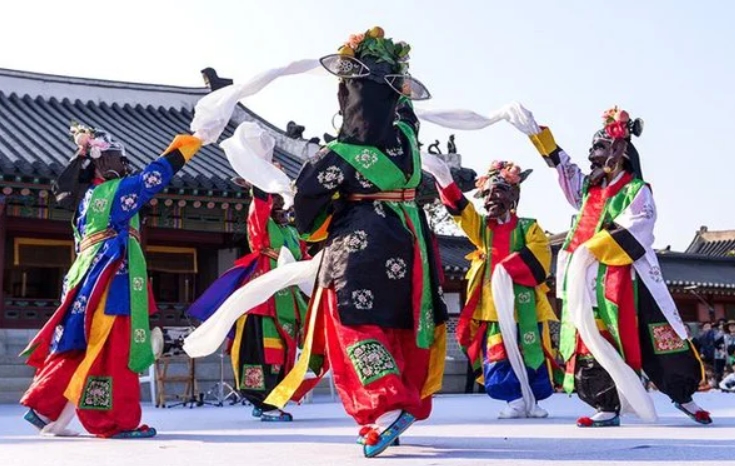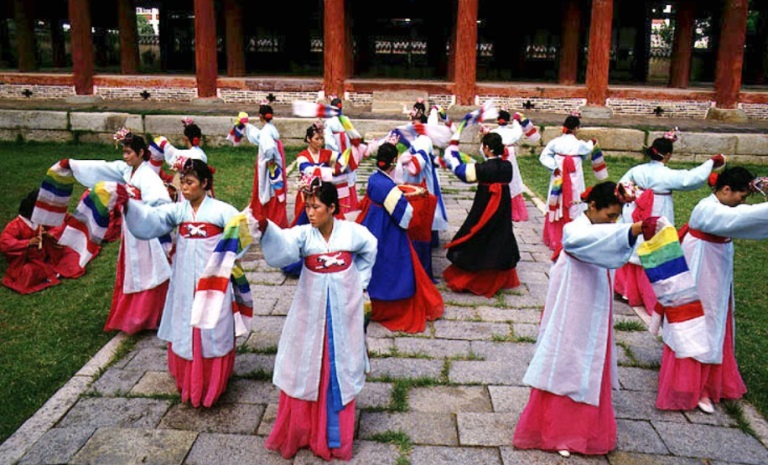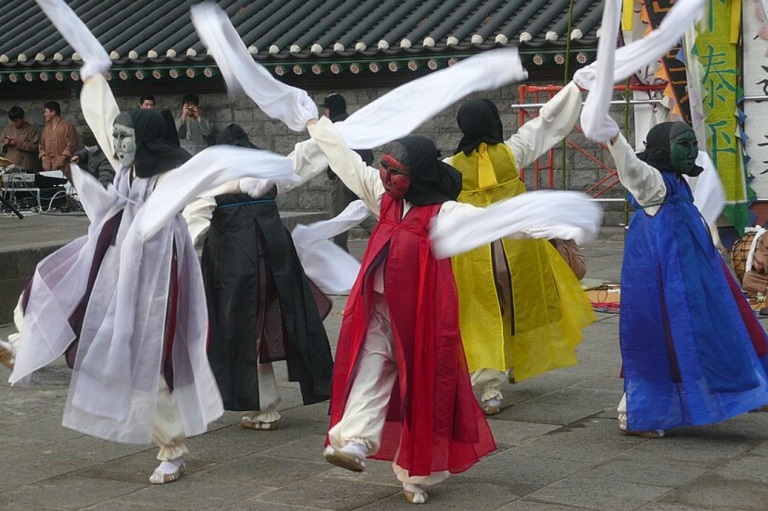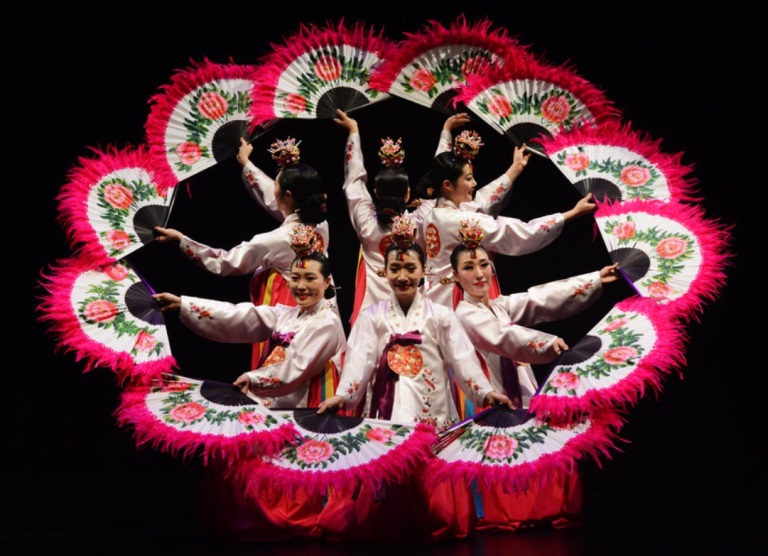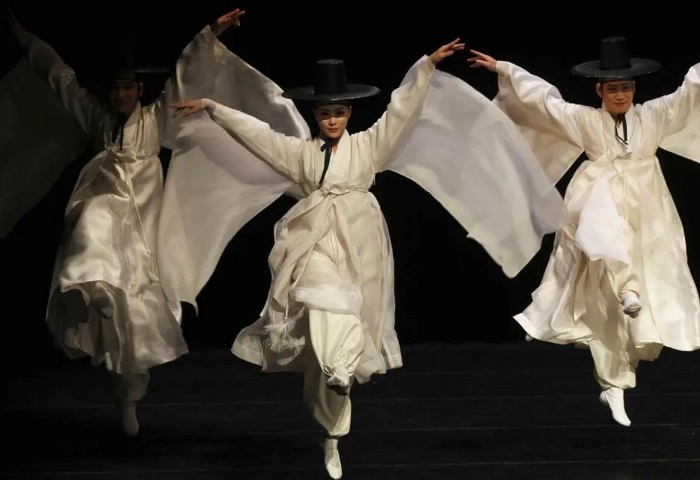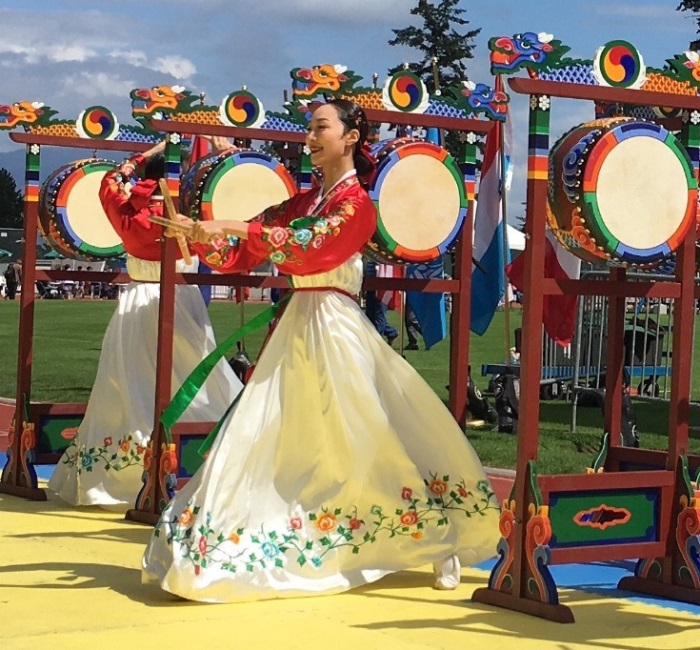No matter how many trends Korean people come up with every day, the way they preserve traditional Korean dances along with the unique cultural details is something we must talk about.
If you are in love with Korea’s classic choreography, you will certainly have a good time learning about them through our article!
Table of Contents
Traditional Korean Dance History
The history of Korean traditional dances traces as far as approximately 5,000 years ago when shaman rituals were very popular. The dances in this era were practices to pray to the Gods and ask for their blessings.
When Indigenous Koreans started living in separate villages, each of them tended to have an exclusive belief, followed by corresponding services provided by the shamans.
Aside from religious culture, these folk dances also became a collective activity for commoners.
Korean dances evolved once more when kingdoms stepped into the scene. Confucianism had a significant impact on the dances and the royal court approved of it.
Due to this acceptance and encouragement, dance companies and academies were born, and the peak was the Ministry of Dance.
Under the influence of Imperial Japan, the development of Korean dances was suppressed and controlled, leading to Korean dancers suffering. The annexation era caused some dances to be gone forever.
The major reason this form of art can survive is the tireless and relentless efforts of many choreographers and dancers.
Characteristics Of Traditional Korean Dance
In most traditional dances from Korea, we will find a storyline telling us more about life in Korea, as if every dance has a story behind it.
For example, the character portrayed in the Ghost Dance is a widow seeing their spouse once more, and the second goodbye brings so much more grief. You will pick up similar stories in the next section of this article.
This aspect of traditional dances from Korea was revived after the annexation era by Japan.
Based on what remained, a humble group of dancers was determined to secretly preserved the lost dances and eventually breathe new life into them.
Dance students nowadays must learn the traditional routines as an obligation.
In terms of techniques, a dominant feature in pure Korean dances is the suspension created using the feet, the continuous flow of energy, and curved shapes with a distinctive heaviness to them.
We can categorize Korean traditional dances into 3 main groups: folk dances, religious dances, and court dances. The quintessence of them varies from satire and humor to discipline and elegance.
You’ll love: 14 Best K-Pop Dancers
Popular Traditional Korean Dances That Endure Today
Dance of Cheoyong (Cheoyongmu)
The Origins
The Cheoyongmu is one of the older Korean dances with a long history of evolvement and improvement.
About 1,100 years ago, in the ninth century when the Silla Kingdom was united, the Emperor and his officials were heading to the Eastern coast when a thick fog took over.
The officials immediately reported to the Emperor that the God of the Ocean was in a rage. And they could only soothe his wrath by doing good deeds.
The Emperor approved and ordered to have a church built nearby. The fog immediately dissipated as the Ocean God led his sons onto the esplanade for sacrifices and danced to show their gratitude.
Cheoyong, one of the Ocean God’s sons, decided to stay in the human world. When a deity of calamity offended Cheoyong, he danced instead of letting his fury take over, and it moved the deity’s heart.
The deity promised to not show up anywhere Cheoyong went. Hence, Cheoyong became a symbol to ward the evils off.
The Performance
Cheoyongmu is a court dance performed in solemn feasts. It is also part of the ritual to chase the malicious spirits away during New Year’s Eve.
The performance includes five dancers, indicating the four directions and the center of the space. Each of them has an outfit of distinctive color (blue, white, red, black, and yellow) and a red mask with unmistakable details.
For accessories, they wear black hats with seven peaches and two peonies for fortune, coupled with lead-bead necklaces and tin earrings. All of them are a reference to traditional craftsmanship.
The movements in Cheoyongmu are very strong and versatile as if from great fighters that the evils wouldn’t dare to cross. People have faith that carving related images on the front gate would protect them from illnesses.
Since 1979, Cheoyongmu was listed as a South Korean Intangible Cultural Property. In 2009, UNESCO acknowledged the dance as one of its Intangible Cultural Heritages.
Check more: All Of Traditional Thai Dances
Dance of Military Triumph (Seungjeonmu)
The Origins
About 2,000 years ago, Seungjeonmu was created to honor the God of Earth. Archaeologists found paintings by Goguryeo ancestors, which depicted dancers in long-sleeved dresses following a circular formation.
They would hold the ritual and dance to Seungjeonmu before going to war, in hopes of getting God’s blessing. Two versions were being executed by young entertainers for centuries: drum and sword.
The Seungjeonmu witnessed a change when Admiral Yi Sun-Shin demanded his soldiers to dance with the drum for morale and with the sword for victory. However, the Seungjeonmu we know of and discuss today is mostly the drum dance.
In the present, this dance is mainly performed in celebration of Admiral Yi’s birthday and death anniversary.
The Performance
The sword dancer wears an archery outfit and holds dual blades called Hansam. Meanwhile, the drum dancer has a flower hat, a dress with various colors, and a matching stick. They will dance to the music created by drums.
A proper performance of Seongjeonmu includes 8 performers divided into two groups: 4 drummers and 4 dancers.
In terms of dance techniques, the Seongjeon dance requires advanced foot movements with 3 steps back and 3 steps forth at a quick pace.
Dongnae Crane Dance (Dongnae Hak ch’um)
The Origins
There is no recording of the origins or the time when the Dongnae Crane Dance was created. But many experts believe it is a variation of older dances that withstand the test of time.
The facts we know are the Dongnae district has a unique shape with the signature features of a crane. A lot of places in Dongnae have something related to cranes.
The people here decided to combine this trait with recreational activities for their hot springs.
So much refining has been done that the Dongnae movements no longer imitated a real crane but incorporated symbolism instead.
Today, the Dongnae dance is commonly seen in Busan events. There are various training programs and clubs for people who enjoy this dance, some of them improvised and simplified the original dance so more enthusiasts can learn it as a hobby.
The Performance
Dongnae dancers wear a white set with a hat and coat as a depiction of white cranes. They play compatible instruments like janggo (drums with an hourglass shape), jing & kkwaenggwari (large and small gong), and traditional drums.
To deliver the image of a crane, the dancers have to be masterful and delicate with their motions. The large-sized sleeves resembling the wings contribute so much to the overall effect.
The rules of Dongnae Hakchum are quite basic, though it gives the dancers more versatility in styles and expressions. The duration and the number of performers are also unlimited!
Gainjeonmokdan

The Origins
Gainjeonmokdan is translated to ‘The Beauty picking up the peonies’, a dance originating from the Joseon Dynasty, roughly two centuries ago.
Korean people said Crown Prince Hyomyeong came up with this dance as his filial way toward King Sunjo, his father.
As the peony is one of the flowers related to the royalties, the Gainjeonmokdan is said to be a court dance demonstrating their pastimes.
Furthermore, the colorful but elegant vibe makes it very compatible with solemn banquets.
The Performance
In the center of the stage, there will be a large vase of peonies.
The dancers are divided into two groups on either side of the platform and only move in when the music starts. Each of them will take one peony and perform elegant moves while holding the flower in their hand.
The requirements for Gainjeonmokdan are control and gracefulness, for it should put the audience in a carefree and peaceful state of mind.
Ghost Dance
The Origins
The Ghost Dance is one of the routines performed by shamans. Although it is a rather humble origin, the influence of the dance earned it a noble status. The most convincing proof is it still survives today.
The story behind the Ghost Dance is the reunion of the main character (portrayed by the dancer) with their deceased spouse.
However, the current of life and death is unchangeable. Once the inevitable goodbye came, their second separation was much more painful.
The Performance
The origins of the Ghost Dance have fixated an emotional touch on it. Hence, the dancers have to be skillful and expressive enough to deliver both the joy of the reunion and the agony of the second farewell.
The Ghost Dance is also a good example of the storytelling characteristics of traditional Korean dance performances.
Jinsoe Dance
The Origins
Jinsoe is another dance created and improved by Korean royalty. In important ceremonies wherein they prayed for the fortune and prosperity of the entire nation as well as successful harvests for the farmers, the Jinsoe dance will be performed.
According to the lore passed down generations, the Emperor would organize a feast under the witness of the Manjo White House and order the magistrates in a certain region to dance.
It was a ritual done when the country was looking forward to a bountiful harvest or suffering decline.
The Performance
What made Jinsoe stand out from other dances is the combination of shaman movements and court dance styles. It is the only known routine that blends these two styles and offers a great result in return.
The court style added an agile and elegant feel to the dance moves, while the shamanistic aspect contributed to the religious and simple nature of the dance.
Korean Fan Dance (Buchaechum)
The Origins
‘Buchae’ means ‘the fan’ and ‘chum’ means the dance. Hence, we have the name Buchaechum, a dance from shamans’ practices dedicated to the gods from thousands of years ago.
Eventually, the dance is detached from the ritual and turned into a performance with high values in both aesthetics and entertainment.
The modern Buchaechum has adapted so much and truly improved enough to be a signature Korean dance.
Nowadays, in conferences involving other countries, this dance is usually chosen as one of the performances.
The Performance
Even in the early days, Buchaechum has always been a combination of our love for Mother Nature and the innovation of culture. The dance depicts the colors and motions of leaves and flowers along with ripples on a water surface.
Consequently, the outfit of Buchaechum dancers looks intricate as well. Its name is Dangui, including a long dress and an upper piece with long sleeves.
The front and the back of their shirts feature an embroidered phoenix with glittery beads.
For the accessory, the dancers will wear a headband as their crown and hold a pink hand fan with flower patterns. Radiant colors and lively details will make the dance moves more attractive and alive.
In the beginning, the dancers will cover their faces with the fans.
Only one of them will reveal her face and gracefully navigate the large fan around herself before the others join her and create a spectacular view with the fans wavering like butterfly wings.
Dance lovers consider this Korean traditional fan dance to be the most feminine and smooth in Asia. Aside from the symbolism of natural beauty, it is also flattering for the tenderness of women.
Monk Dance (Seungmu)
The Origins
Many people believe that the Monk dance was inspired by Shamanism, while others are very convinced by the theory of a Buddism root.
According to a tale, the first Seungmu dancer is Hwang Ji Ni, a gorgeous entertainer who wanted to entice Jijok Seonsa, a noble believer who then forwent everything for her.
Another story said Seungmu was a variation of the Talchum dance, wherein a Buddhism monk was seduced by a woman who turned out to be a betrayer.
Either way, the origins of Seungmu would still be religious and spiritual, thus it underwent a ban during the era of the Joseon dynasty.
In 1969, the Seungmu was recognized as the 27th among Korea’s essential Intangible Cultural assets.
The Performance
Most of the time, we will see Seungmu as a solo performance with only the drum and one dancer in a shaman outfit. The most eye-catching detail in this dance is the shawl tangling and dangling from their the dancer’s arms.
Many researchers find the Monk dance to be the most interesting traditional performance because of the colorful clothes and the seamless movements on a drum beat.
With seven repertoires, the dancers have sufficient materials to shuffle and surprise the audience. They create a space with the long bands of fabrics and connect the movements into an endless flow.
The challenge for them is to blend the solemnity of the music with the sophisticated and graceful motions of their bodies. More than ever, they need to dance with an earnest heart and an honest soul.
Prodiga Man Dance (Hallyangmu)
The Origins
Hallyang is a community of noble youths from the Joseon era who spend all their time doing what they want and running after idle fun.
Therefore, the theme and the topic for Hallyangmu are very expansive, as it covers the daily routine of noble individuals, officials, and even monks.
To this day, Hallyangmu still exists as a dance for shamanic rituals, especially during the Baekjung festival.
The Performance
Hallyangmu was originally a stunt for people of the lower ranks, though it became a performance for adult audiences only after the disappearance of those entertainers.
Once again, the storytelling nature of Korean dances is showcased explicitly. Despite the limited choices of clothes for the dancers, there are so many tales they could tell through dance moves, thus their creativity has a chance to sail.
Salpuri
The Origins
Although the music and the routine brought to us through the Salpuri dance seem rather tragic and sorrowful, they hide a prayer beneath that facade.
Salpuri took inspiration from the Southern and Midwestern cleansing rituals. People of the old days believed their souls need to be cleared and purified from mundane attachments before they can go to the other side and have a new start.
Furthermore, a departing soul would leave behind harmful elements. Thus, its community has to join hands and eliminate the negative remains from their collective well-being before it targets one of them and causes misfortunes or grievances.
Salpuri is among the oldest traditional dances in Korea, and it was listed as the 97th Intangible Cultural Asset of the country.
The Performance
The signature of the Salpuri dance is the mourning music called Sinawi, in which the soul finds solace. It is a series of beats with no sheets and notes.
Initially, shamans were responsible for heightening the effectiveness through dancing, hence the dancers later on somehow felt like a conductor as well.
Some people find Salpuri very challenging because it is a solo performance, usually executed by the most experienced dancer in the group.
The only necessary prop for Salpuri dancers is a long scarf, the rest depends on how much they can pull off an overwhelming yet underlying strength with tamed movements.
On the outside, you will only see hand and arm pauses and snaps. So, the physical movements are extremely limited yet they have to carry introvertedness and willpower.
Check more: What Is Troika Dance?
Sword Dance (Tonggyong Kommu)
The Origins
The oldest origin referred to Korean sword dancing is hwarang, an institution consisting of young men training in military and cultural arts. Therefore, we can trace it back as far as the Silla dynasty (Year 57 B.C).
Other than the hwarang origin, the Sword dance was also related to court dances and seldom performed for villagers.
The Performance
As the name indicates, the dancers will perform with a sword and maintain it in a parallel line with the audience while moving in a circular shape.
This posture remains even when the performance ends, as the dancers bow and back away from the stage.
The attractiveness of Tonggyong Kommu is the slow tempo that gives off a serious and solemn atmosphere.
A few experts suggested incorporating military actions, though the best form of the Sword dance is perhaps still the composure of regal dancers amidst a flurry of swords.
Three Drum Dance
The Origins
Also known as the Samgomu, the Three Drum routine is probably the most Buddhism drum dance. The dancers need to showcase both dancing techniques and drumming skills.
Akin to the Fan dance, the Three Drum dance is a traditional dance that combines well with modern touches and results in a more contemporary version.
The Performance
Based on the name, the most common formation for the Three Drum dance is a group of three dancers. However, depending on the requirements and the purposes, the choreographers can include up to twenty members in the team.
Unlike the aforementioned dances, the Three Drum routine demands teamwork because each dancer and their drum is put between two other teammates. If they can’t move in sync, the overall effects will never be satisfying.
Final Words
Each traditional Korean dance plays an important role in maintaining a beautiful aspect of culture and transferring a bit of history to younger generations.
The dances are full of artistic values and enriched with the time they partake in our life, like a friendly invitation for us to come and explore this beautiful country.
